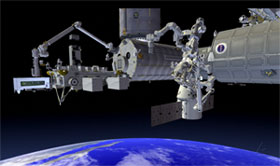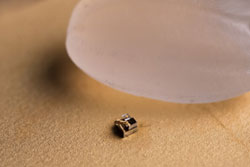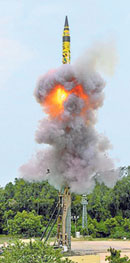June 2018 Science and Technology
Sakshi Education

- NASA’s ECOSTRESS set to correct agricultural water imbalances
NASA plans to install ECOSTRESS on the International Space Station (ISS) that will measure the temperature of plants from space, enabling researchers to determine plant water use and to study how drought conditions affect plant health.
ECO system Spaceborne Thermal Radiometre Experiment on Space Station, or ECOSTRESS will hitch a ride to the space station on a SpaceX cargo resupply mission scheduled to launch from Cape Canaveral Air Force Station in Florida on June 29, NASA said.
ECOSTRESS is one of two instruments selected in July for NASA's Earth Venture-Instrument series of missions. These missions are part of the Earth System Science Pathfinder program, managed by NASA's Langley Research Center in Hampton, Virginia, for NASA's Science Mission Directorate.
The water is released through pores on the plants’ leaves through a process called transpiration. If there is not enough water available to the plants, they close their pores to conserve water, causing their temperatures to rise.
Plants use those same pores to take up carbon dioxide from the atmosphere for photosynthesis If they continue to experience insufficient water availability, or “water stress,” they eventually starve or overheat, and die.
By looking at ECOSTRESS imagery of a certain location over the course of days to weeks, scientists will be able to see how evapotranspiration varies in that location throughout the day. This is important, because plants that get enough water in the cool of the morning might shut down in afternoon heat.
Existing satellite instruments that monitor evapotranspiration offer either high spatial resolution but low time frequency (a couple of measurements a month), or high time frequency and coarse spatial resolution (1,600 feet, or 500 meters square). Scientists, farmers and water managers need both high resolution and high frequency. ECOSTRESS will provide a four-day repeat cycle and a spatial resolution of 125 feet (38 meters) by 185 feet (57 meters), high enough to see most farms and small differences within ecosystems.
- World’s smallest computer device created to monitor, treat cancer
 Scientists have developed the world's smallest computer a device that measures just 0.3 millimetres and could help find new ways to monitor and treat cancer.
Scientists have developed the world's smallest computer a device that measures just 0.3 millimetres and could help find new ways to monitor and treat cancer.
Previous systems, including the 2x2x4 millimetre Michigan Micro Mote, retain their programming and data even when they are not externally powered.
Unplug a desktop computer, and its program and data are still there when it boots itself up once the power is back. However, these new micro devices lose all prior programming and data as soon as they lose power.
In addition to the RAM and photovoltaics, the new computing devices have processors and wireless transmitters and receivers. Since they are too small to have conventional radio antennae, they receive and transmit data with visible light. A base station provides light for power and programming, and it receives the data.
The system is very flexible and could be reimagined for a variety of purposes, but the team chose precision temperature measurement, as some studies suggest that tumors run hotter than normal tissue, but the data isn't solid enough for confidence on the issue. Temperature may also help in evaluating cancer treatments.
- India to soon start producing first indigenous Lithium-Ion batteries
 India will soon start producing first indigenous Lithium Ion batteries. A memorandum of understanding for transfer of technology for India’s first Lithium Ion (Li-ion) Battery project was signed between CSIR’s Central Electro Chemical Research Institute (CECRI), Karaikudi, Tamil Nadu and RAASI Solar Power Pvt Ltd.
India will soon start producing first indigenous Lithium Ion batteries. A memorandum of understanding for transfer of technology for India’s first Lithium Ion (Li-ion) Battery project was signed between CSIR’s Central Electro Chemical Research Institute (CECRI), Karaikudi, Tamil Nadu and RAASI Solar Power Pvt Ltd.
At present India depends on countries like China, Japan and South Korea for import of Lithium Ion batteries. India imported Li-Ion batteries worth 150 million dollar in 2017 and is one of its largest importers in the world.
The project is in tune with Prime Minister Narendra Modi vision of "Make in India", to turn India into a manufacturing hub and to cut down outflow of foreign exchange.
According to Harshavardhan, Minister for Science and Technology, it will give tremendous boost to two flagship programmes of Mr Narendra Modi - increasing the share of Clean Energy in the energy basket by generating 175 Giga Watts by 2022 and the second, National Electric Mobility Mission, to switch completely to electric vehicles by 2030.
The indigenous technology of Lithium-ion cells has been developed by a group of CSIR-CECRI headed by Dr Gopu Kumar in partnership with other Laboratory and Research Institute.
- India Successfully Test-Fires Nuclear Capable Agni-5 Ballistic Missile
 India successfully test-fires indigenously developed nuclear capable long range Ballistic missile Agni-5 off Odisha coast.
India successfully test-fires indigenously developed nuclear capable long range Ballistic missile Agni-5 off Odisha coast.
India successfully test-fired its indigenously developed nuclear capable Long Range Ballistic Missile, Agni-5 from the Abdul Kalam Wheeler Island off the Odisha coast.
The state-of-the-art surface-to-surface missile developed by the Defence Research and Development Organisation (DRDO) has a strike range of 5,000 kilometres and can carry a nuclear warhead of more than one tonne. It is about 17 metres long, 2 metres wide and has launch weight of around 50 tonnes.
This is the sixth developmental and third trial of the long range missile. Unlike other missiles of Agni series, the latest one ‘Agni-5’ is the most advanced having new technologies incorporated with it in terms of navigation and guidance, warhead and engine.
Agni-5 will be inducted into the Services. Once this missile is inducted in Services, India will join the super exclusive club of countries with Inter-Continental Ballistic Missiles ICBMs alongside the US, Russia, China, France and the UK.
Published date : 06 Jul 2018 12:20PM



















